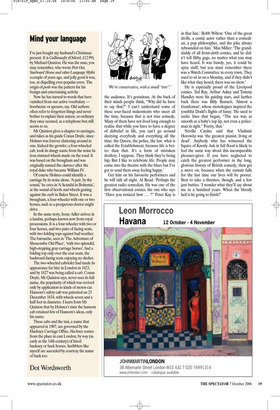Mind your language
I’ve just bought my husband’s Christmas present. It is Gallimaufry (Oxford, £12.99) by Michael Quinion. He was the man, you may remember, who wrote Port Out, Starboard Home and other Language Myths a couple of years ago, and jolly good it was, too, at dispelling ever-popular error. The origin of posh was the pattern for his benign and entertaining activity.
Now he has turned to words that have vanished from our active vocabulary bombazine or apozem, say. Old authors often refer to forgotten things and never bother to explain their nature, so ordinary they once seemed, as a telephone box still seems to us.
Mr Quinion gives a chapter to carriages, and takes as his guide Conan Doyle, since Holmes was forever clattering around in one. Indeed the growler, a four-wheeled cab, took its slangy name from the noise its iron-rimmed wheels made on the road. It was based on the brougham and was originally named the clarence after the royal duke who became William IV.
Of course Holmes could identify a carriage by its noise alone. ‘A pair, by the sound,’ he cries in ‘A Scandal in Bohemia’, at the sound of hoofs and wheels grating against the curb in Baker Street. It was a brougham, a four-wheeler with one or two horses, such as a prosperous doctor might drive.
In the same story, Irene Adler arrives in a landau, perhaps known now from royal processions. It is a four-wheeler with two or four horses, and two pairs of facing seats, with two folding tops against bad weather. The barouche, seen in ‘The Adventure of Shoscombe Old Place’, ‘with two splendid, high-stepping gray carriage horses’, had a folding top only over the rear seats, the backward-facing seats enjoying no shelter.
The two-wheeled cabriolet had made its appearance for hire in London in 1823, and by 1827 was being called a cab. Conan Doyle, Mr Quinion says, never uses its full name, the popularity of which was revived only by application to kinds of motor-car. Hansom’s safety-cab was patented on 23 December 1834, with wheels seven and a half feet in diameter. I learn from Mr Quinion that by Holmes’s time the hansom cab retained few of Hansom’s ideas, only his name.
These cabs and the taxi, a name that appeared in 1907, are governed by the Hackney Carriage Office. Hackney comes from the place in east London, by way (as early as the 14th century) of hired hackney or hack horses. Scribblers like myself are accorded by courtesy the name of hack too.
Dot Wordsworth


















































































 Previous page
Previous page